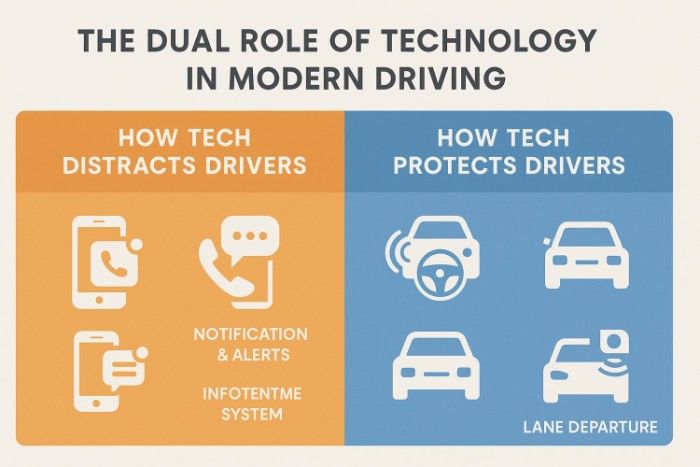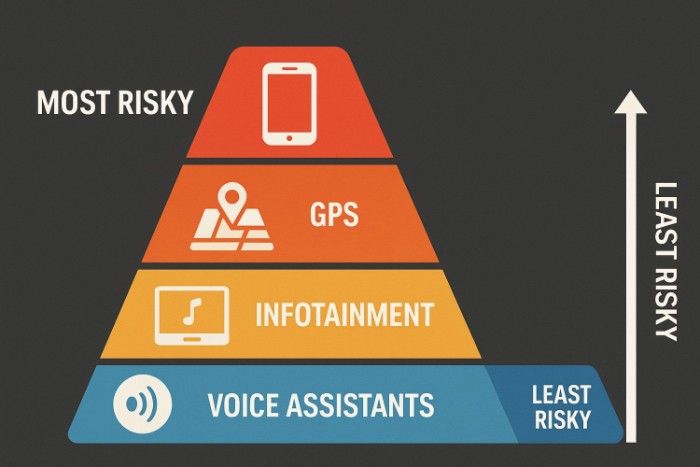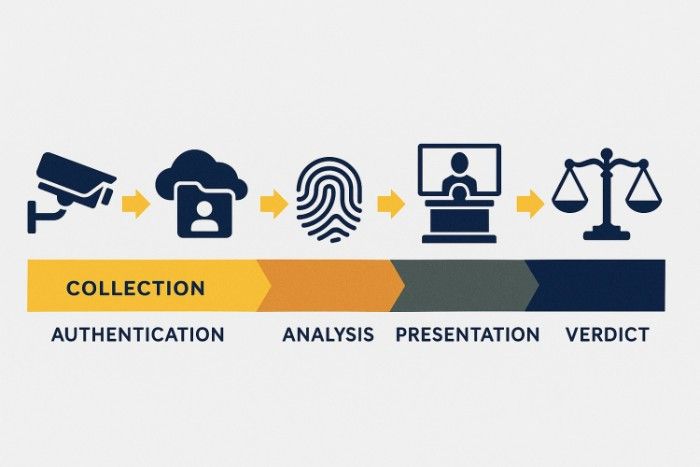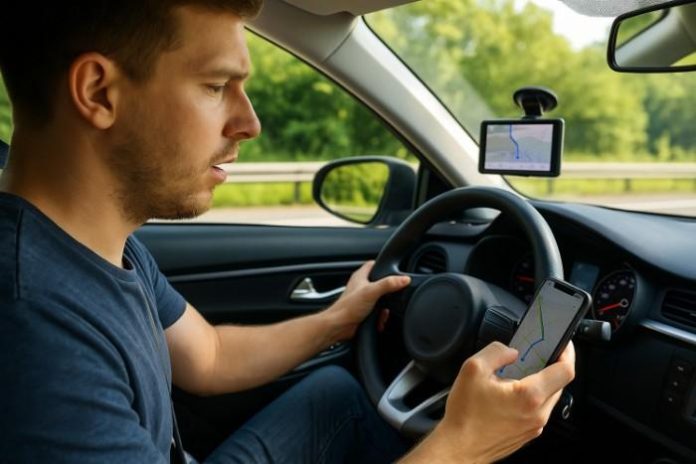Technology has transformed modern driving, making vehicles more advanced, connected, and efficient. However, this innovation comes with a cost: an increasing number of drivers are succumbing to distractions from their devices. Smartphones, touchscreens, and even in-car entertainment systems often compete for attention, turning convenience into danger within seconds. The temptation to multitask answering texts, changing playlists, or glancing at a GP creates split-second lapses that can have lifelong consequences.
At the same time, technology is also part of the solution. Automakers and app developers are working to create tools that enhance focus, improve safety, and reduce driver error. Understanding both sides of this issue is key to creating safer roads. When distraction leads to an accident, victims should consult with a car accident lawyer to explore their legal rights and pursue compensation for their injuries.
Table of contents
- The Dual Role of Technology in Modern Driving
- How Smartphones Became the Leading Source of Distraction
- Common Tech Distractions Drivers Face
- The Rise of Safety Technology in Modern Cars
- Apps That Help Prevent Distracted Driving
- Balancing Connectivity and Safety
- Legal Accountability and the Role of Technology Evidence
- Building a Safer Future Through Smart Innovation
The Dual Role of Technology in Modern Driving

Technology has created a mixed situation on the road. It offers great convenience with GPS, instant communication, and entertainment. However, it also encourages drivers to multitask, which can be dangerous. Just checking a message or scrolling through social media for a few seconds can significantly increase the chance of a crash. Research shows that even a two-second distraction can double the risk of an accident.
On the other hand, these same technologies are being used to address this issue. Driver-assistance features like lane departure warnings, automatic braking, and eye-tracking sensors aim to prevent accidents caused by human mistakes. Car manufacturers are focusing on creating smarter systems that watch how drivers behave and can take action when needed. The tools that once distracted drivers are now being redesigned to help save lives.
How Smartphones Became the Leading Source of Distraction
Smartphones are one of the greatest culprits behind distracted driving. Notifications, texts, and navigation apps constantly demand attention, turning each buzz or vibration into a potential hazard. Even hands-free devices can pull a driver’s mental focus away from the road, as listening and responding to a call divide cognitive resources needed for safe driving.
In Virginia and across the U.S., laws now prohibit the use of handheld devices while driving. Despite these restrictions, distracted driving crashes continue to rise because legislation alone cannot change habits. The problem lies in dependency drivers are accustomed to constant connection, making it difficult to disconnect even for short trips. Real progress will come not only from enforcement but from cultural change and improved awareness.
Common Tech Distractions Drivers Face

Not all distractions come from phones. Modern cars have technology that is meant to make driving easier, but it can also be unsafe. Touchscreens and infotainment systems may look nice, but they often make drivers look away from the road or take their hands off the wheel.
Below are some of the most common technology-based distractions drivers encounter:
- Touchscreen Controls: Adjusting music, temperature, or navigation mid-drive.
- Infotainment Systems: Streaming video or using apps that divert focus.
- GPS and Maps: Typing destinations instead of setting them before departure.
- Smartwatches: Notifications or fitness alerts prompting glances and taps.
- Bluetooth Calls: Hands-free conversations that still reduce mental attention.
- Driver Notifications: Vehicle alerts or pop-ups requiring on-screen responses.
Each distraction lasts mere seconds, yet at 55 miles per hour, those seconds can equal the length of a football field driven with closed eyes. The result is often catastrophic when drivers underestimate how quickly distractions escalate into collisions.
The Rise of Safety Technology in Modern Cars
Automakers have recognized the dangers of distracted driving and are integrating safety technology to counter it. Features like forward-collision warning, adaptive cruise control, and blind-spot monitoring use sensors and AI to help drivers stay alert and avoid crashes. These systems can automatically detect lane drifting, sudden braking ahead, or obstacles in blind zones, responding faster than human reflexes.
Advanced driver-assistance systems (ADAS) act as a digital safety net, intervening when a driver’s reaction time is too slow. Lane-keeping assist can gently steer a drifting vehicle back into position, while automatic emergency braking can stop a car before a crash occurs. The integration of such tools represents a step toward semi-autonomous driving, where technology complements not replaces human responsibility behind the wheel.
Apps That Help Prevent Distracted Driving
Smartphone apps are now emerging as tools for prevention rather than risk. Some apps automatically silence notifications, block calls, or send automatic replies while driving. Parents can also use monitoring apps to track their teen drivers’ phone use and receive alerts when unsafe behaviors occur.
Many insurance companies encourage these preventive technologies by offering lower premiums or safe-driving rewards to users who activate them. This shift from reactive to proactive safety reflects a new philosophy: instead of punishing distraction after the fact, technology can prevent it from happening in the first place.
Balancing Connectivity and Safety
The modern world demands constant connection but staying connected shouldn’t come at the cost of safety. Drivers can take proactive steps to balance technology use with responsible driving habits. Silencing notifications, planning routes in advance, and setting playlists before departure are simple yet powerful precautions that reduce temptation.
Education also plays a crucial role. Schools, employers, and safety organizations can raise awareness about the dangers of distracted driving. When drivers understand that distraction isn’t just risky it’s negligent they’re more likely to make responsible choices. A single mindful decision to ignore a notification can mean the difference between a safe arrival and a tragic accident.
Legal Accountability and the Role of Technology Evidence

When technology leads to a crash, digital evidence becomes crucial in proving negligence. Attorneys can obtain cellphone records, analyze vehicle data, and review traffic camera footage to show that a driver was distracted during the collision. Even data from infotainment systems can reveal when a driver used a touchscreen.
Working with an experienced attorney helps ensure this evidence is collected and presented correctly. Legal teams can link distraction, slow reactions, and resulting injuries to help victims recover costs for medical bills, lost wages, and emotional pain. While technology can cause distractions, it also provides the proof needed to hold careless drivers accountable.
Building a Safer Future Through Smart Innovation
Technology is changing, and it is not going away. The challenge is to use it safely and responsibly. Automakers, app developers, and lawmakers must work together to keep safety as a top priority. This includes utilizing AI-based monitoring systems and enforcing stricter laws against distracted driving.
The aim involves achieving a balance where technology improves safety instead of risking it. As people become more aware and new systems grow smarter, roads can become safer for everyone. Innovating responsibly and driving carefully allows technology to transform from a problem into a real solution.











